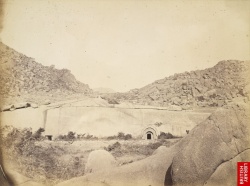Barabar Caves
The Barabar Caves are the oldest surviving rock-cut caves in India, mostly dating from the Mauryan period (322–185 BCE), and some with Ashokan inscriptions, located in the Jehanabad District of Bihar, India, 24 km north of Gaya.
These caves are situated in the twin hills of Barabar (four caves) and Nagarjuni (three caves) - caves of the 1.6 km distant Nagarjuna Hill sometimes are singled out as Nagarjuni Caves.
These rock-cut chambers date back to the 3rd century BC, Maurya period, of Ashoka (r. 273 BC to 232 BC.) and his son, Dasaratha.
Though Buddhists themselves, they allowed various Jain sects to flourish under a policy of religious tolerance.
These caves were used by ascetics from the Ajivika sect, founded by Makkhali Gosala, a contemporary of Siddhartha Gautama, the founder of Buddhism, and of Mahavira, the last and 24th Tirthankara of Jainism.
Also found at the site were several rock-cut Buddhist and Hindu sculptures.
Most caves at Barabar consist of two chambers, carved entirely out of granite, with a highly polished internal surface and exciting echo effect.
The first chamber was meant for worshippers to congregate in a large rectangular hall, and the second, a small, circular, domed chamber for worship, this inner chamber probably had a small stupa like structure, at some point, though they are now empty.
Caves at Barabar Hill
Barabar Hill contains four caves, namely, Karan Chaupar, Lomas Rishi, Sudama and Visva Zopri.
Sudama and Lomas Rishi Caves are the earliest examples of rock-cut architecture in India, with architectural detailing, made in the Mauryan period, and became a trend the subsequent centuries, like the larger Buddhist Chaitya, that were found in Maharashtra, such as in Ajanta and Karla Caves, and greatly influenced the tradition of South Asian rock-cut architecture.
Barabar caves have magnanimous arches which are few in ancient history.
- Lomas Rishi cave: The arch-like shape facade of Lomas Rishi Caves, imitate the contemporary timber architecture. On the doorway, a row of elephants ::proceed towards stupa emblems, along the curved architrave.
The caves consist of a ::circular vaulted chamber with a rectangular mandapa.
- Karan Chaupar (Karna Chaupar): Consists of single rectangular room with polished surfaces, contains inscription which could be dated to 245 BC.
- Visva Zopri: Reachable by Asoka steps hewn in cliff, consists of two rectangular rooms.
Nagarjuni Caves
Nearby caves of Nagarjuna are smaller and younger than Barabar caves The three caves are:
- Gopi (Gopi-ka-Kubha): According to inscription, devoted by the king Dasaratha to Ajivika followers circa 232 BC.
- Vadithi-ka-Kubha cave (Vedathika Kubha): Located in crevice.
- Vapiya-ka-Kubha cave (Mirza Mandi): Also devoted to Ajivika followers by Dasaratha.
